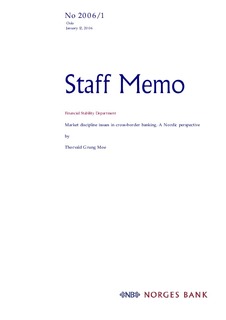| dc.description.abstract | Cross-border banking is on the rise. Large, cross-border banks have been established in the Nordic, Baltic and Benelux countries. Banco Santander’s takeover of Abbey National made headline news last year, and this year the bid by the Dutch bank ABN Amro for the ninth largest Italian bank Antonveneta has been front-page news for months. And just lately, the Benelux group Fortis was reported to have approached the Franco-Belgian group Dexia with a merger proposal. As cross-border banks increase in size, it is relevant to ask if stakeholders in these megamergers banks are exposed to the true risks involved, or if they expect the financial safety net to bail them out – should a crisis occur. National authorities could also be exposed in case of a failure in a cross-border bank, but the potential liability facing taxpayers has so far been masked by unclear home-host responsibilities for cross-border banks. Crisis resolution in a cross-border bank is obviously the responsibility of the bank’s owners and management, but previous banking crises have shown that authorities must also have contingency arrangements in place. Cross-border banks pose new challenges for policy makers. Goodhart (2005) has noted that “the interaction of an internationally inter-penetrated banking system with national regulations and burden allocation could well turn out to be a dangerously weak institutional feature.” The policy response has been to seek greater clarity in roles and responsibilities. Supervisory convergence and coordinated liquidity provision are being discussed among supervisors and central banks. Clarke (2005) even asks if an international liquidity concordat for large cross-border banks should be considered. But is this drive for convergence and agreement on intervention principles realistic? And is it desirable? What if greater clarity about roles and responsibilities were to weaken market discipline? In the following we review some of the issues involved and discuss their possible impact on market discipline. Most of the home-host discussion has so far been centered on supervisory issues. There has been less attention to the role of central banks, especially in cross-border crisis resolution. We refer to some of the issues that have been discussed among the Nordic central banks. We conclude that international agreements on crisis resolution and burden sharing will be hard to achieve. Private sector solutions should therefore be promoted, while public authorities should take measures that will make their non-intervention policy credible. | nb_NO |

